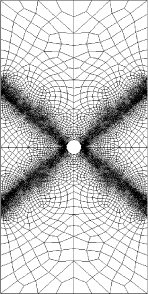CS/CNS 257c:
Simulation

The essence of simulation is the construction of computational analogues of the physical behavior of real world structures and their efficient implementation on the computer. In this course students will learn how to go from a physical phenomenon to a set of differential equations describing it and efficient computational strategies to solve the equations. Examples include stationary and instationary heat conduction, elasticity, and convection diffusion problems. The course will cover the underlying theory, such as wellposedness and uniqueness of solutions, as well as the foundations of the finite element method and its mathematical analysis. On the algorithmic side we will study both numerical issues such as proper choice of discretizations and equation solvers as well as the design and analysis of data structures and discrete algorithms. Examples include Delaunay triangulations, graph partitioning, and fast spatial search.
Requirements: Both theoretical and programming assignments will be given throughout the class. There will be no midterm or final.
Prerequisites: Undergraduate linear algebra and calculus, and some programming experience. Previous exposure to numerical analysis is useful, but not required.